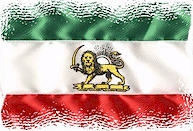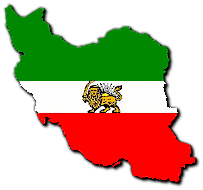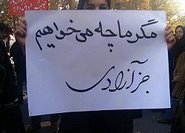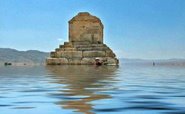Alliance For democracy In Iran
Please have a look at my other weblog, Iran Democracy - http://irandemocray.blogspot.com/
IMPERIAL EMBLEM

PERSIA
Shahanshah Aryameher
S U N OF P E R S I A
Iranian Freedom Fighters UNITE
Wednesday, July 11, 2007
20 More Executions Under Way in Iran : Nazila Fathi :The New York Times
July 10, 2007 -- TEHRAN -- The Iranian government confirmed Tuesday that a man was executed by stoning last week for committing adultery, and said that 20 more men would be executed in the coming days on morality violations. A judiciary spokesman, Alireza Jamshidi, told reporters on Tuesday that a death sentence by stoning had been carried out last week near the city of Takestan, west of Tehran, despite an order by the chief of the judiciary, Ayatollah Mahmoud Shahroudi, not to permit such executions. “The verdict was final, and so it was carried out for the man but not for the woman,” the ISNA news agency quoted Mr. Jamshidi as saying. He said the 20 additional executions were for such things as “rape, insulting religious sanctities and laws, and homosexuality.” Most executions in Iran are hangings, often in public and at the scenes of the alleged crimes. The police arrested about 1,000 people in May during a so-called morality crackdown. Mr. Jamshidi said 15 more men were being tried on similar charges and could receive death sentences. The daily newspaper Etemad Melli reported Monday that Jaffar Kiani, 47, who had been convicted of adultery, was executed by stoning on Thursday in the cemetery of a small village near Takestan. “Villagers said the sentence was carried out by the local judge and authorities,” the newspaper reported. Mr. Kiani and his partner, Mokarameh Ebrahimi, 43, who has two children, were scheduled to die on June 21, but the execution was put off by Ayatollah Shahroudi.
In or Out : July 11, 2007 : The New York Times : Thomas Friedman
When it comes to Iraq, September will be coming early this year — like now.
Democrats, and a growing number of Republicans, are determined not to wait until September for the president to report on whether the surge is working. The American people have had enough. They want out. As we move into the endgame, though, the public needs to understand that neither Republicans nor Democrats are presenting them with a realistic strategy. Obviously, President Bush’s stay-the-course approach is bankrupt. It shows no signs of producing any self-sustaining — and that is the metric — unified, stable Iraq. But the various gradual, partial withdrawal proposals by many Democrats and dissident Republicans are not realistic either. The passions that have been unleashed in Iraq are not going to accommodate some partial withdrawal plan, where we just draw down troops, do less patrolling, more training and fight Al Qaeda types. It’s a fantasy. The minute we start to withdraw, all hell will break loose in the areas we leave, and there will be a no-holds-barred contest for power among Iraqi factions. Our staying there with, say, half as many troops, will not be sustainable. Look at the British in Basra. The British forces there have slowly receded into a single base at Basra airport. And what has happened? The void has been filled by a vicious contest for power among Shiite warlords, gangs and clans, and British troops are still being killed whenever they venture out. As the International Crisis Group recently reported from Basra: “Basra’s political arena is in the hands of actors engaged in bloody competition for resources, undermining what is left of governorate institutions and coercively enforcing their rule. Far from being a model to replicate, Basra is an example of what to avoid. With renewed violence and instability, Basra illustrates the pitfalls of a transitional process that has led to the collapse of the state apparatus.” We must not kid ourselves: our real choices in Iraq are either all in or all out — with the exception of Kurdistan. If those are our only real choices, then we need to look clearly at each. Staying in means simply containing the Iraqi civil war, but at the price of Americans and Iraqis continuing to die, and at the price of the U.S. having no real leverage on the parties inside or outside of Iraq to negotiate a settlement, because everyone knows we’re staying so they can dither. Today, U.S. soldiers are making the maximum sacrifice so Iraqi politicians can hold to their maximum positions. Getting out, on the other hand, means more ethnic, religious and tribal killings all across Iraq. It will be one of the most morally ugly scenes you can imagine — no less than Darfur. You will see U.S. troops withdrawing and Iraqi civilians and soldiers who have supported us clinging to our tanks for protection as we rumble out the door. We need to take with us everyone who helped us and wants out, and give green cards to as many Iraqis as possible. But getting out has at least four advantages. First, no more Americans will be dying while refereeing a civil war. Second, the fear of an all-out civil war, as we do prepare to leave, may be the last best hope for getting the Iraqis to reach an 11th-hour political agreement. Third, as the civil war in Iraq plays out, it could, painfully, force the realignment of communities on the ground that may create a more stable foundation upon which to build a federal settlement. Fourth, we will restore our deterrence with Iran. Tehran will no longer be able to bleed us through its proxies in Iraq, and we will be much freer to hit Iran — should we ever need to — once we’re out. Moreover, Iran will by default inherit management of the mess in southern Iraq, which, in time, will be an enormous problem for Tehran. For all these reasons, I prefer setting a withdrawal date, but accompanying it with a last-ditch U.N.-led — not U.S. — diplomatic effort to get the Iraqi parties to resolve their political differences. If they can, then any withdrawal can be postponed. If they can’t agree — even with a gun to their heads about to go off — then staying is truly pointless and leaving by a set date is the only option. “It is one thing to try to break up a fight between two people who disagree; it is another thing to try to break up a riot,” said Michael Mandelbaum, a foreign policy expert at Johns Hopkins. “You just get sucked into the middle.” We need to determine — now, today — whether this is a fight that can be resolved or a riot that we need to build a wall around and wait until it exhausts itself.
U.S., Iran do Persian Gulf Squeeze
July 11, 2007 Los Angeles Times Borzou Daragahi
ABOARD THE USS JOHN C. STENNIS -- Iran and the United States remain so far apart on so many issues that they refuse to talk about them. But in the cramped sea routes of the Persian Gulf, U.S. and Iranian warship sailors and fighter pilots speak to each other daily. They have to. They're practically jostling one another in courteous games of surveillance, counter-surveillance and geopolitical posturing.
"We are operating very close to their territorial waters in a very confined space with a tremendous amount of traffic, be it the small dhows, be it the supertankers going up to the oil platforms," said U.S. Navy Capt. Sterling Gilliam Jr., commander of air operations for this nuclear-powered supercarrier and its associated ships. "The margin of error is smaller in that the space is more confined. That would be the case even if anyone was your ally, just because of the sheer small size of the Arabian Gulf," Gilliam said, using an alternative name for the body of water. Even mundane changes of direction require chitchat with Iranian counterparts. When sedate gulf winds fade to a whisper, for example, this 100,000-ton carrier whips up to the 25 knots required to hurl jets into flight from the 1,092-foot flight deck. But first the vessel alerts nearby forces of Iran's Revolutionary Guard and the organization's navy. "We would do the standard international maritime measures," said Capt. Bradley Johanson, commanding officer of the aircraft carrier. "We would call them on their radio and say, 'Sir, I just wanted to let you know that we're going to be turning to port and be coming to this course so that we're into the wind in support of our flight operation." The Iranians respond professionally and courteously, Johanson said: " 'Thank you very much for the information. We will move off to the starboard position. We very much appreciate the heads-up.' " Nearly half of the U.S. Navy's 277 warships are stationed close to Iran, alongside most of Tehran's estimated 140 naval surface ships and six submarines, according to GlobalSecurity.org. More than five dozen aircraft are aboard the Stennis, along with dozens more aboard the Nimitz, another U.S. aircraft carrier in the gulf. -- Multiple roles Crew members on the Stennis say they are here to provide aircraft for peacekeeping and counterinsurgency missions in Iraq, Afghanistan and Somalia. But few doubt they are also here to send a message to Iran, which the U.S. accuses of pursuing a clandestine nuclear weapons program and supporting anti-American militants from Lebanon to Afghanistan. "My feeling here is we're here to show our resolve, and to protect our friends," said Cmdr. Marcus Hitchcock, the Stennis' executive officer. A flotilla of nine U.S. warships steamed through the Strait of Hormuz two months after the United Nations Security Council passed the last round of sanctions against Iran for continuing with its uranium enrichment program and Iranians seized 15 British sailors and marines in disputed waters off Iraq. Positioning two aircraft carrier groups in the gulf gives the United States the capability to operate 24 hours a day and potentially conduct about 180 daily bombing and surveillance operations over Iran. It also means the United States may be deploying nuclear weapons, believed to be aboard some of the ships in the aircraft carrier groups, within 10 miles of Iran's shores. -- Big targets But the aircraft carriers, each accompanied by four or five other ships, could become big targets for Iran in the event of a war. "It's going to be very hard to defend U.S. ships against small ships and volleys of missiles in the confines of the Persian Gulf," said Joseph Cirincione, a security analyst at the Center for American Progress, a Washington think tank. "This is not an ideal situation for the Navy." Tensions between Iran and the U.S. lie barely beneath the surface of the delicate maritime protocol. Both Iran and the U.S. regularly dispatch spy planes to watch each other. A photograph of an Iranian T-12 reconnaissance plane is posted outside the intelligence office of the Stennis. "Image of the day," says the caption. "We would take a picture of an Iranian navy warship to see if they've made any changes," said Vice Adm. Kevin J. Cosgriff, commander of the Bahrain-based U.S. 5th Fleet. "They do it too. We pay attention and want to know where they are. Is their action routine or are they getting ready for an exercise?" Each country accuses the other of bad behavior. Iran says the U.S. plays a disruptive role in the gulf and destabilizes the region. U.S. officials say the Iranians behave like bullies, sometimes getting on the radio to order Americans to leave what the Iranians claim as territorial waters. Americans also complain that Iranians don't do enough to clear sea lanes before conducting missile tests in international waters and that their aircraft fly too close to U.S. planes. "They're overt about it," Cosgriff said. "They're communicating." Operating an aircraft carrier is a task that requires precision and stamina even in the most spacious waters. Stumbling into a hot conflict with the Iranians remains a constant concern in the overcrowded gulf, where nearby oil wells glow orange in the steamy night, and wooden dhows, steel-hull freighters and warships navigate the waterway by day. On the ship's computer maps, a thick black line delineates Iranian coastal waters from the rest of the gulf. Shades of gray mark the waters off Saudi Arabia and the United Arab Emirates, allies of the United States. U.S. pilots are told to stay well away from Iranian airspace. "We do worry about miscalculations," Cosgriff said. "That's one of the reasons we want to be transparent on the radio and be talking to them a lot."
In or Out : July 11, 2007 : The New York Times : Thomas Friedman
When it comes to Iraq, September will be coming early this year — like now.
Democrats, and a growing number of Republicans, are determined not to wait until September for the president to report on whether the surge is working. The American people have had enough. They want out. As we move into the endgame, though, the public needs to understand that neither Republicans nor Democrats are presenting them with a realistic strategy. Obviously, President Bush’s stay-the-course approach is bankrupt. It shows no signs of producing any self-sustaining — and that is the metric — unified, stable Iraq. But the various gradual, partial withdrawal proposals by many Democrats and dissident Republicans are not realistic either. The passions that have been unleashed in Iraq are not going to accommodate some partial withdrawal plan, where we just draw down troops, do less patrolling, more training and fight Al Qaeda types. It’s a fantasy. The minute we start to withdraw, all hell will break loose in the areas we leave, and there will be a no-holds-barred contest for power among Iraqi factions. Our staying there with, say, half as many troops, will not be sustainable. Look at the British in Basra. The British forces there have slowly receded into a single base at Basra airport. And what has happened? The void has been filled by a vicious contest for power among Shiite warlords, gangs and clans, and British troops are still being killed whenever they venture out. As the International Crisis Group recently reported from Basra: “Basra’s political arena is in the hands of actors engaged in bloody competition for resources, undermining what is left of governorate institutions and coercively enforcing their rule. Far from being a model to replicate, Basra is an example of what to avoid. With renewed violence and instability, Basra illustrates the pitfalls of a transitional process that has led to the collapse of the state apparatus.” We must not kid ourselves: our real choices in Iraq are either all in or all out — with the exception of Kurdistan. If those are our only real choices, then we need to look clearly at each. Staying in means simply containing the Iraqi civil war, but at the price of Americans and Iraqis continuing to die, and at the price of the U.S. having no real leverage on the parties inside or outside of Iraq to negotiate a settlement, because everyone knows we’re staying so they can dither. Today, U.S. soldiers are making the maximum sacrifice so Iraqi politicians can hold to their maximum positions. Getting out, on the other hand, means more ethnic, religious and tribal killings all across Iraq. It will be one of the most morally ugly scenes you can imagine — no less than Darfur. You will see U.S. troops withdrawing and Iraqi civilians and soldiers who have supported us clinging to our tanks for protection as we rumble out the door. We need to take with us everyone who helped us and wants out, and give green cards to as many Iraqis as possible. But getting out has at least four advantages. First, no more Americans will be dying while refereeing a civil war. Second, the fear of an all-out civil war, as we do prepare to leave, may be the last best hope for getting the Iraqis to reach an 11th-hour political agreement. Third, as the civil war in Iraq plays out, it could, painfully, force the realignment of communities on the ground that may create a more stable foundation upon which to build a federal settlement. Fourth, we will restore our deterrence with Iran. Tehran will no longer be able to bleed us through its proxies in Iraq, and we will be much freer to hit Iran — should we ever need to — once we’re out. Moreover, Iran will by default inherit management of the mess in southern Iraq, which, in time, will be an enormous problem for Tehran. For all these reasons, I prefer setting a withdrawal date, but accompanying it with a last-ditch U.N.-led — not U.S. — diplomatic effort to get the Iraqi parties to resolve their political differences. If they can, then any withdrawal can be postponed. If they can’t agree — even with a gun to their heads about to go off — then staying is truly pointless and leaving by a set date is the only option. “It is one thing to try to break up a fight between two people who disagree; it is another thing to try to break up a riot,” said Michael Mandelbaum, a foreign policy expert at Johns Hopkins. “You just get sucked into the middle.” We need to determine — now, today — whether this is a fight that can be resolved or a riot that we need to build a wall around and wait until it exhausts itself.
U.S., Iran do Persian Gulf Squeeze
July 11, 2007 Los Angeles Times Borzou Daragahi
ABOARD THE USS JOHN C. STENNIS -- Iran and the United States remain so far apart on so many issues that they refuse to talk about them. But in the cramped sea routes of the Persian Gulf, U.S. and Iranian warship sailors and fighter pilots speak to each other daily. They have to. They're practically jostling one another in courteous games of surveillance, counter-surveillance and geopolitical posturing.
"We are operating very close to their territorial waters in a very confined space with a tremendous amount of traffic, be it the small dhows, be it the supertankers going up to the oil platforms," said U.S. Navy Capt. Sterling Gilliam Jr., commander of air operations for this nuclear-powered supercarrier and its associated ships. "The margin of error is smaller in that the space is more confined. That would be the case even if anyone was your ally, just because of the sheer small size of the Arabian Gulf," Gilliam said, using an alternative name for the body of water. Even mundane changes of direction require chitchat with Iranian counterparts. When sedate gulf winds fade to a whisper, for example, this 100,000-ton carrier whips up to the 25 knots required to hurl jets into flight from the 1,092-foot flight deck. But first the vessel alerts nearby forces of Iran's Revolutionary Guard and the organization's navy. "We would do the standard international maritime measures," said Capt. Bradley Johanson, commanding officer of the aircraft carrier. "We would call them on their radio and say, 'Sir, I just wanted to let you know that we're going to be turning to port and be coming to this course so that we're into the wind in support of our flight operation." The Iranians respond professionally and courteously, Johanson said: " 'Thank you very much for the information. We will move off to the starboard position. We very much appreciate the heads-up.' " Nearly half of the U.S. Navy's 277 warships are stationed close to Iran, alongside most of Tehran's estimated 140 naval surface ships and six submarines, according to GlobalSecurity.org. More than five dozen aircraft are aboard the Stennis, along with dozens more aboard the Nimitz, another U.S. aircraft carrier in the gulf. -- Multiple roles Crew members on the Stennis say they are here to provide aircraft for peacekeeping and counterinsurgency missions in Iraq, Afghanistan and Somalia. But few doubt they are also here to send a message to Iran, which the U.S. accuses of pursuing a clandestine nuclear weapons program and supporting anti-American militants from Lebanon to Afghanistan. "My feeling here is we're here to show our resolve, and to protect our friends," said Cmdr. Marcus Hitchcock, the Stennis' executive officer. A flotilla of nine U.S. warships steamed through the Strait of Hormuz two months after the United Nations Security Council passed the last round of sanctions against Iran for continuing with its uranium enrichment program and Iranians seized 15 British sailors and marines in disputed waters off Iraq. Positioning two aircraft carrier groups in the gulf gives the United States the capability to operate 24 hours a day and potentially conduct about 180 daily bombing and surveillance operations over Iran. It also means the United States may be deploying nuclear weapons, believed to be aboard some of the ships in the aircraft carrier groups, within 10 miles of Iran's shores. -- Big targets But the aircraft carriers, each accompanied by four or five other ships, could become big targets for Iran in the event of a war. "It's going to be very hard to defend U.S. ships against small ships and volleys of missiles in the confines of the Persian Gulf," said Joseph Cirincione, a security analyst at the Center for American Progress, a Washington think tank. "This is not an ideal situation for the Navy." Tensions between Iran and the U.S. lie barely beneath the surface of the delicate maritime protocol. Both Iran and the U.S. regularly dispatch spy planes to watch each other. A photograph of an Iranian T-12 reconnaissance plane is posted outside the intelligence office of the Stennis. "Image of the day," says the caption. "We would take a picture of an Iranian navy warship to see if they've made any changes," said Vice Adm. Kevin J. Cosgriff, commander of the Bahrain-based U.S. 5th Fleet. "They do it too. We pay attention and want to know where they are. Is their action routine or are they getting ready for an exercise?" Each country accuses the other of bad behavior. Iran says the U.S. plays a disruptive role in the gulf and destabilizes the region. U.S. officials say the Iranians behave like bullies, sometimes getting on the radio to order Americans to leave what the Iranians claim as territorial waters. Americans also complain that Iranians don't do enough to clear sea lanes before conducting missile tests in international waters and that their aircraft fly too close to U.S. planes. "They're overt about it," Cosgriff said. "They're communicating." Operating an aircraft carrier is a task that requires precision and stamina even in the most spacious waters. Stumbling into a hot conflict with the Iranians remains a constant concern in the overcrowded gulf, where nearby oil wells glow orange in the steamy night, and wooden dhows, steel-hull freighters and warships navigate the waterway by day. On the ship's computer maps, a thick black line delineates Iranian coastal waters from the rest of the gulf. Shades of gray mark the waters off Saudi Arabia and the United Arab Emirates, allies of the United States. U.S. pilots are told to stay well away from Iranian airspace. "We do worry about miscalculations," Cosgriff said. "That's one of the reasons we want to be transparent on the radio and be talking to them a lot."
Subscribe to:
Post Comments (Atom)
























 اخبار مربوط به زندانیان سیاسی و نقض حقوق بشر
اخبار مربوط به زندانیان سیاسی و نقض حقوق بشر

















 Tulips in Holland
Tulips in Holland












No comments:
Post a Comment